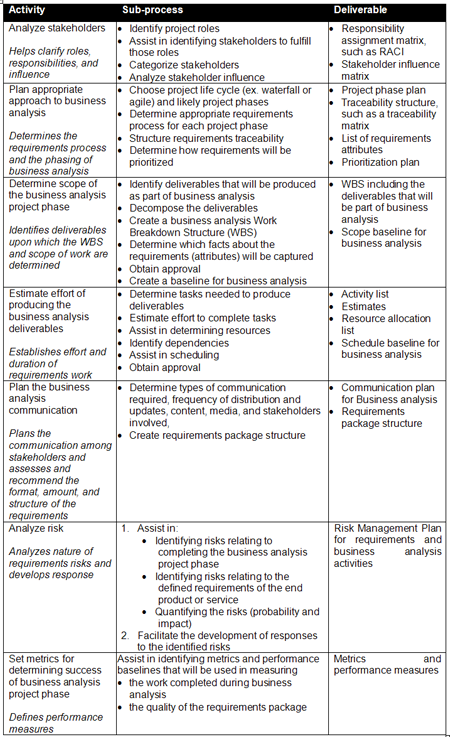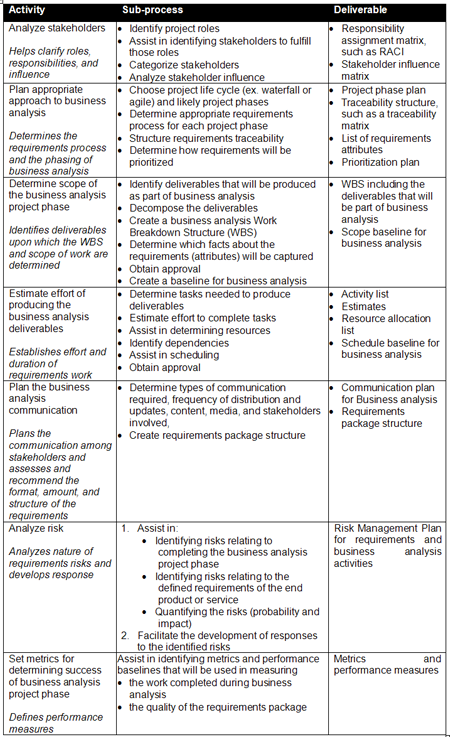Now that we have looked at the framework for requirements management, let’s delve deeper into requirements planning.
The Requirements Management Plan
Planning the business analysis work effort is part of the overall effort to plan the project, and the resulting Requirements Management Plan becomes part of the project management plan. Below is a table with some of the key planning activities, the sub-processes associated with each, and the final deliverables that are produced. As stated earlier, these deliverables are rolled into the requirements management plan, which in turn, is a subsidiary plan within the overall project management plan.
Because of the interrelationship of the project and the product, of the project manager and the business analyst, most of the activities below, while focusing on the product or activities to produce the product, are part of the larger project. The effective project manager, in planning for the whole project, seeks input from a variety of team members to create scope, schedule, and cost baselines. One of these team members is the business analyst, who provides input on the business analysis phase or phases. In other words, the business analyst plans which activities will be needed to define the product requirements completely and correctly. The information from business analysis feeds into the overall project.
Below is a table which expands on the activities in the knowledge area of business analysis planning and monitoring, the processes within the broader tasks, and the key deliverables that are output from these processes.
Exhibit 3 – Requirements Planning Activities and Deliverables
It is helpful to remember that each of these activities and sub-processes should be considered and performed, although not with the same amount of formality. For example, identifying project roles can take place in a formal, facilitated session with cross-functional representation, or it can occur when the project professional informally touches base with a limited number of stakeholders. Likewise, the deliverables may be permanent and stored in a repository or they can be temporary, a by-product of an informal conversation. In the latter example, the deliverable may be produced on a whiteboard and erased at the end of the discussion, kept in notes until the end of the project, or archived indefinitely. What is important is that these decisions be made purposefully and before the execution of business analysis has occurred.
Clarifying Roles
One of the first tasks in requirements planning is completing stakeholder analysis, during which time it is important to clarify the project professional’s role and associated responsibilities. Because of the interrelationship of the project and product, the roles of project manager and business analyst tend to blur in some organizations and on some projects. Here are several considerations to help clarify these two roles:
- The difference between the function of managing the project and that of managing both the requirements and the business analysis phase(s). Although the same person can certainly manage both functions, they are different and the associated roles are also different. Skills required and characteristics of effective performance differ for each role, so giving thought to each during stakeholder analysis is important. For example, it is even more important for the project manager than the business analyst to have human resource management skills, and it is even more important for the latter to be an expert facilitator.
- The consultative nature of the project professional’s role. In establishing roles and responsibilities it is important to view the project professional as a consultant who makes recommendations, rather than either as an owner or as an order-taker. One of the required skills is the ability to influence without authority. A responsibilities assignment matrix, such as a RACI, can help with this clarification.
- The importance of distinguishing between requirements management and product ownership is also critical. We need to remember that managing requirements does not mean owning them. When clients are not available, it is rarely in the best interest of the project to continue without executive and business client support. Since it is the sponsor who has a business problem needing a solution, the sponsor needs to assign people who can define what they want in a timely manner. The project professional can have input and can certainly make recommendations, but the final decisions and acceptance of the requirements need to rest with sponsors. Therefore it is necessary to clarify the sponsor’s role as the ultimate owner, even if they have chosen to designate a day-to-day project owner.
- Finally, project professionals need to keep asking why the stated business problem is worth solving and to explain why it’s in the sponsor’s best interest to provide available resources who can define the requirements that will solve the business problem.
The next article in the series explores the consultative nature of the project professional and provides tips for negotiating to ensure there is enough project time for requirements management.
Elizabeth Larson, CBAP, PMP and Richard Larson, CBAP, PMP are Principals, Watermark Learning, Inc. Watermark Learning helps improve project success with outstanding project management and business analysis training and mentoring. We foster results through our unique blend of industry best practices, a practical approach, and an engaging delivery. We convey retainable real-world skills, to motivate and enhance staff performance, adding up to enduring results. With our academic partner, Auburn University, Watermark Learning provides Masters Certificate Programs to help organizations be more productive, and assist individuals in their professional growth. Watermark is a PMI Global Registered Education Provider, and an IIBA Endorsed Education Provider. Our CBAP Certification Preparation class has helped several people already pass the CBAP exam. For more information, contact us at 800-646-9362, or visit us at
http://www.watermarklearning.com.


 Summer tends to become a bit of a habit, doesn’t it? And it’s a habit that’s often hard to kick. But no excuses! We have some articles that we feel sure will provide food for thought and help get you back into the business swing of things. I think you’ll find them a mix of pretty sophisticated business analysis ideas and techniques coupled with some getting the job done in general. Take a read and let us know what you think because that’s what helps us continue to run a website that is for and about you and your profession. And, talking of reading, don’t miss our new Bookstore that we set up just last month. It’s got a wealth of great BA books by leaders in the field.
Summer tends to become a bit of a habit, doesn’t it? And it’s a habit that’s often hard to kick. But no excuses! We have some articles that we feel sure will provide food for thought and help get you back into the business swing of things. I think you’ll find them a mix of pretty sophisticated business analysis ideas and techniques coupled with some getting the job done in general. Take a read and let us know what you think because that’s what helps us continue to run a website that is for and about you and your profession. And, talking of reading, don’t miss our new Bookstore that we set up just last month. It’s got a wealth of great BA books by leaders in the field.
